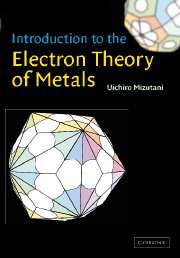Book contents
- Frontmatter
- Contents
- Preface
- 1 Introduction
- 2 Bonding styles and the free-electron model
- 3 Electrons in a metal at finite temperatures
- 4 Periodic lattice, and lattice vibrations in crystals
- 5 Conduction electrons in a periodic potential
- 6 Electronic structure of representative elements
- 7 Experimental techniques and principles of electronic structure-related phenomena
- 8 Electronic structure calculations
- 9 Electronic structure of alloys
- 10 Electron transport properties in periodic systems (I)
- 11 Electron transport properties in periodic systems (II)
- 12 Superconductivity
- 13 Magnetism, electronic structure and electron transport properties in magnetic metals
- 14 Electronic structure of strongly correlated electron systems
- 15 Electronic structure and electron transport properties of liquid metals, amorphous metals and quasicrystals
- Appendix 1 Values of selected physical constants
- Principal symbols (by chapter)
- Hints and answers
- References
- Materials index
- Subject index
15 - Electronic structure and electron transport properties of liquid metals, amorphous metals and quasicrystals
Published online by Cambridge University Press: 20 November 2009
- Frontmatter
- Contents
- Preface
- 1 Introduction
- 2 Bonding styles and the free-electron model
- 3 Electrons in a metal at finite temperatures
- 4 Periodic lattice, and lattice vibrations in crystals
- 5 Conduction electrons in a periodic potential
- 6 Electronic structure of representative elements
- 7 Experimental techniques and principles of electronic structure-related phenomena
- 8 Electronic structure calculations
- 9 Electronic structure of alloys
- 10 Electron transport properties in periodic systems (I)
- 11 Electron transport properties in periodic systems (II)
- 12 Superconductivity
- 13 Magnetism, electronic structure and electron transport properties in magnetic metals
- 14 Electronic structure of strongly correlated electron systems
- 15 Electronic structure and electron transport properties of liquid metals, amorphous metals and quasicrystals
- Appendix 1 Values of selected physical constants
- Principal symbols (by chapter)
- Hints and answers
- References
- Materials index
- Subject index
Summary
Prologue
When a crystal is melted, the periodic lattice is destroyed and the atomic distribution is randomized. This causes the Bloch theorem to fail in liquid metals. The discussion of the conduction electron in liquid metals dates back as early as 1936 when the Mott and Jones book on the electron theory of metals was first published. Since the 1970s, new melt-quenching techniques have been developed and amorphous alloys stable at room temperature have become available in ribbon form. A bundant production of thermally stable amorphous alloys has enabled us to study their electron transport properties down to very low temperatures and has certainly widened the research field in the electron theory of a non-periodic system.
In 1984, Shechtman et al. revealed that the electron diffraction pattern of the melt-quenched Al86Mn14 alloy exhibits two-, three- and five-fold symmetries incompatible with the translational symmetry of a crystal and suggested that this material belongs to a new family of substances different from crystals. Since then a number of solids of this class have been discovered along with progress in theoretical studies. They are indeed new solids classified, in crystallographic terms, as quasicrystals. Because of the possession of five-fold symmetry incompatible with the translational symmetry, the Bloch theorem breaks down. Hence, they are grouped together with liquid metals and amorphous alloys into the category of non-periodic systems in spite of the possession of a high degree of ordering, evidenced from very sharp Bragg reflections.
The fundamental understanding of the atomic structure of quasicrystals has been deepened through the construction of a quasiperiodic Penrose lattice obtained by projecting lattice points in a selected region of a six-dimensional lattice onto a three-dimensional physical space.
- Type
- Chapter
- Information
- Introduction to the Electron Theory of Metals , pp. 451 - 515Publisher: Cambridge University PressPrint publication year: 2001
- 1
- Cited by

